FavRoute Itinerary of :
The Caves Connect
485 enquiries 0 followers 532 views 0 driversIncluded are : Stay, Meals, Activities, *Base Price : Rs.1750/ pax / dayPackage Price : Rs.3500/ pax / dayThis trip can be availed as a package or at Base Price.Trip plan type : Flexi Plan*Days - 8 -- Nights - 7.
Total travel distance : 1273-Kms..
Min Pax - 3 -- Max Pax - 4
Sends a WhatsApp msg with your interest to the trip owner.Call the trip owner.Start point atA - Chhatrapati Shivaji Maharaj International Airport (BOM),Mumbai, MH
End point atS - Chhatrapati Shivaji Maharaj International Airport (BOM),Mumbai, MH
Share on your social media
Day : 1 - To Historical Daman
Night stay at B1 - Daman, Daman and Diu, India
Distance from days start -188 Kms.
Star Rating of Hotel :



Halt B1 - Daman, Daman and Diu, India
Distance from days start -188 Kms.
Activities - Visit Jampore beach, Devika Beach
Factors at the Halt include : Beach.
On Day 1 of the trip from Mumbai we shall head north to Daman by crossing into Gujarat state. Daman is the capital city of the Dadra and Nagar Haveli and Daman and Diu. It is a municipal council situated in Daman district of the union territory. Daman Ganga River divides Daman into two parts — Nani-Daman (nani meaning "small") and Moti-Daman (Moti meaning "big"). Despite its name, Nani-Daman is the larger of the two parts, while the old city is mainly in Moti-Daman. This holds most of the important entities like the major hospitals, supermarkets and major residential areas. Daman is great as a beach destination with a lot of activities centered around the beaches mainly the watersports. While in Daman, we can visit the Devka beach and the Jampore beach where we can do some watersports. Daman being a Union territory Alcohol is much cheaper than the rest of the country and hence there are quite a few Bars here. The travelers can relax by the seafacing shacks and Bars and enjoy the seafood fare of the region with drinks if they like.
Media and additional information available for the day's itinerary.
![]()
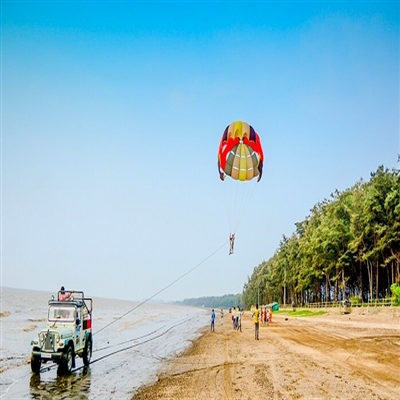
Activities at Jampore beach
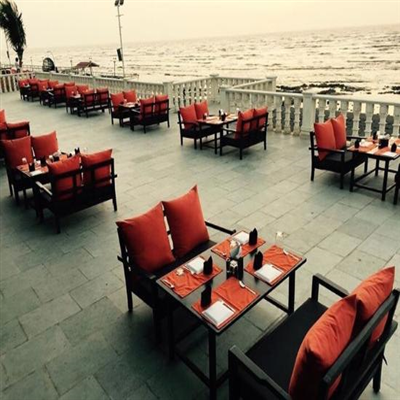
Sea view bars and shacks
.jpg)
Devka Beach

Devka Beach

Jampore Beach
Day : 2 - The wine capital of India
Halt C1 - Sula Vineyards, Gangapur-Savargaon Road, Nashik, Maharashtra, India
Distance from days start -97 Kms.
Activities - Sula Vineyard Tour and Wine Tasting
Factors at the Halt include : Unique Experiences.
Night stay at D2 - Nashik Road, Nashik, Maharashtra, India
Distance from days start -111 Kms.
Star Rating of Hotel :



On next day we shall head out from Daman to Nashik which is a 3.5 hour drive away towards the east. Nashik is the largest city in the northern region of Maharashtra and is the fourth largest city in the state, after Mumbai, Pune and Nagpur. The city is called the "Wine Capital of India" as more than half of India's vineyards and wineries are located here. Around 90% of all wine produced in India comes from the Nashik Valley. So our first stop in Nashik would be Sula Vineyards where we can do a vineyard tour, factory visit and the wine tasting experience in the Sula Vineries. The experience is quite by itself as it is not normally available in any other part of the country.
Media and additional information available for the day's itinerary.
![]()

Nashik city

Nashik City views
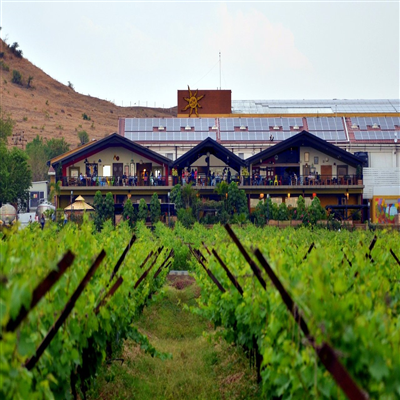
View of Sula Vineyards

Sula Vineyards factory visit
Day : 3 - The Jain cave temples
Halt E1 - Mangi Tungi, Maharashtra, India
Distance from days start -98 Kms.
Activities - Visit Mangi Tungi cave temples
Factors at the Halt include : Spiritual,Treks,Caves / Springs.
Halt F2 - Bhamer Fort, Dhule, Maharashtra, India
Distance from days start -132 Kms.
Activities - Visit Bhamer Fort and Jain Cave temples
Factors at the Halt include : Spiritual,Caves / Springs.
Night stay at G3 - Dhule, Maharashtra, India
Distance from days start -143 Kms.
Star Rating of Hotel :



On Day 3 we shall head north from Nashik to visit the Mangi Tungi fort and cave temples. Mangi-Tungi is a prominent twin-pinnacled peak with plateau. Mangi, 4,343 ft (1,324 m) high above sea level, is the western pinnacle and Tungi, 4,366 ft (1,331 m) high, is the eastern one. Visiting the sites involves trekking to the spots which interests the most to the travelers as there are numerous temples scattered across the sites which is considered sacred in Jainism. It enshrines images of Tirthankaras in several postures including Padmasana and kayotsarga.
Around 3,500 (7,000 Up & Down) steps lead to the foot of the peak, which is enriched with several monuments of historical and religious prominence. Besides, there are numerous caves named after great Tirthankaras such as Mahavira, Rishabhanatha, Shantinatha and Parshvanatha. A grand fair is held here annually during Kartik (September–October) where people visit in large numbers to witness festival.There are many inscriptions on idols, most of them are not clear due to deterioration with time. Many idol installed in 595 CE are here. Many inscriptions on rocks of the Adinatha and Shantinatha caves here are in Sanskrit Language. In February 2016, The Statue of Ahimsa, a 108 ft idol carved in monolithic stone was consecrated here. It is recorded in the Guinness Book of World Records as the tallest Jain idol in the world. From Mangi Tungi 50 km further north on a 1 and half hour drive away is the Bhamer fort and the Jain cave temples. Bhamer is well known for its underground caves which are known as Gavali Raja's House. These caves are located in the escarpments of the hills with some are honeycombed, some of them are plain and shapeless, but others are regular buildings with pillar-supported roofs.
Bhamer, however, is known for its fort known after the village name and more so for the caves or rather monk’s dwellings that are in the escarpments of the hills above the village. The fort located at the cast end of a rugged irregular range of rocky hills is divided from the rest of the range by an artificial chasm. The natural escarpment of the fort that overlooks the village has been strengthened in places by masonry constructions. Though the hill is of a considerable height, the ascent is easy and roundabout. On the southern face is the entrance leading into the fort. Inside are several cisterns of good water as also four large store rooms hollowed out of the rock. There are many ruined gateways and gates and nearly ruined towers. Time has also withered away the artificial fortifications at many places. It is believed that the town was destroyed while chasing Kale Khan, a Muslim rebel, who had seized it in 1736. It never regained its original glory. The city of Dhule is further 60 kms east of Bhamer where we shall be spending the night.
Media and additional information available for the day's itinerary.
![]()

Twin Peaks of Mangi Tungi
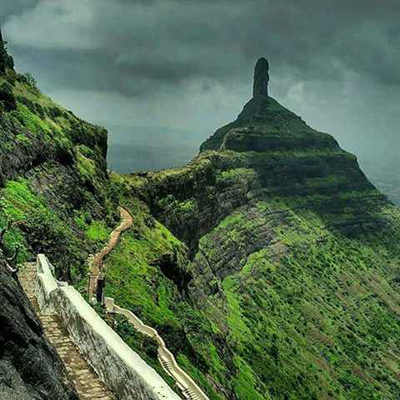
Steps to the peak

The Jain temples at Mangi Tungi

The 108 meter tall Idol at Mangi tungi
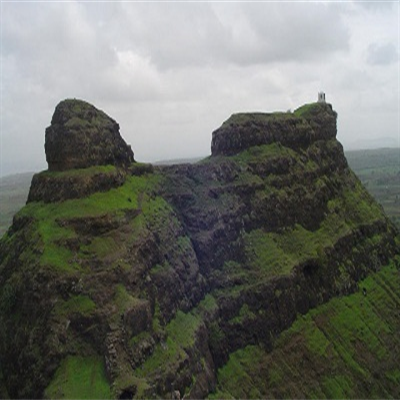
Bhamer Fort
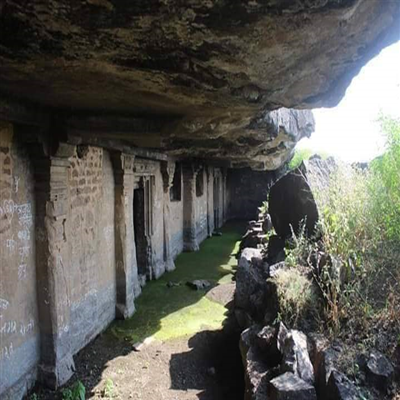
The Jain Cave temples at Bhamer
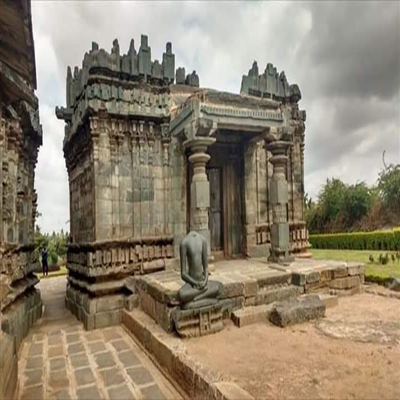
Jain temples at Bhamer
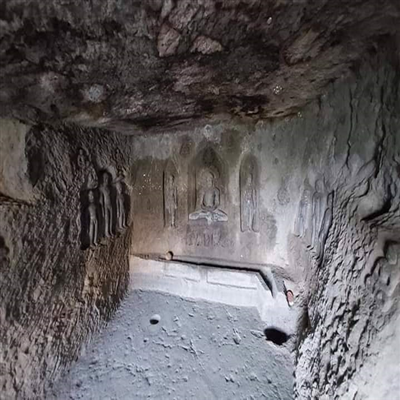
Cave Temples
Day : 4 - Ajanta and Ellora Caves
Halt H1 - Ajanta Caves, Maharashtra, India
Distance from days start -104 Kms.
Activities - Visit Ajanta Caves, Buddhist Religious Shrines
Factors at the Halt include : Spiritual,Caves / Springs.
Halt I2 - Ellora Caves, Ellora Cave Road, Ellora, Maharashtra, India
Distance from days start -105 Kms.
Activities - Visit Ellora Caves
Factors at the Halt include : Spiritual,Cultural / History,Caves / Springs.
Night stay at J3 - Aurangabad, Maharashtra, India
Distance from days start -128 Kms.
Star Rating of Hotel :




On Day 4 we visit the highlight of the trip the Unesco heritage sites of Ajanta and Ellora Caves. Ajanta caves are 130 Kms, and 3 hours drive further South East of Dhule city our origin. The Buddhist Caves in Ajanta are approximately 30 rock-cut Buddhist cave monuments dating from the 2nd century BCE to about 480 CE in the Aurangabad district of Maharashtra. The caves include paintings and rock-cut sculptures described as among the finest surviving examples of ancient Indian art, particularly expressive paintings that present emotions through gesture, pose and form. They are universally regarded as masterpieces of Buddhist religious art. The caves were built in two phases, the first starting around the 2nd century BCE and the second occurring from 400 to 650 CE, according to older accounts, or in a brief period of 460–480 CE according to later scholarship. The site is a protected monument in the care of the Archaeological Survey of India, and since 1983, the Ajanta Caves have been a UNESCO World Heritage Site. The Ajanta Caves constitute ancient monasteries and worship-halls of different Buddhist traditions carved into a 75-metre (246 ft) wall of rock. The caves also present paintings depicting the past lives and rebirths of the Buddha, pictorial tales from Aryasura's Jatakamala, and rock-cut sculptures of Buddhist deities.Textual records suggest that these caves served as a monsoon retreat for monks, as well as a resting site for merchants and pilgrims in ancient India. The Caves 16, 17, 1 and 2 of Ajanta form the largest corpus of surviving ancient Indian wall-painting. The Ellora caves is further 2.5 hour drive south towards the city of Aurangabad. Ellora is a UNESCO World Heritage Site located in the Aurangabad, Maharashtra. It is one of the largest rock-cut Hindu temple cave complexes in the world, featuring Hinduism in particular and few Buddhist and Jain monuments with Artwork dating from the 600–1000 CE period. Cave 16 features the largest single monolithic rock excavation in the world, the Kailash temple, a chariot shaped monument dedicated to Lord Shiva. The Kailash temple excavation also features sculptures depicting the gods, goddesses found in Hinduism as well as relief panels summarizing the two major Hindu Epics. There are over 100 caves at the site, all excavated from the basalt cliffs in the Charanandri Hills, 34 of which are open to public. These consist of 17 Hindu (caves 13–29), 12 Buddhist (caves 1–12) and 5 Jain (caves 30–34) caves, each group representing deities and mythologies prevalent in the 1st millennium CE, as well as monasteries of each respective religion. They were built close to one another and illustrate the religious harmony that existed in ancient India. All of the Ellora monuments were built during the Rashtrakuta dynasty, which constructed part of the Hindu and Buddhist caves, and the Yadava dynasty, which constructed a number of the Jain caves. Funding for the construction of the monuments was provided by royals, traders and the wealthy of the region. Although the caves served as temples and a rest stop for pilgrims, the site's location on an ancient South Asian trade route also made it an important commercial centre in the Deccan region. After visiting Ellora caves and monuments we can head to the city of Aurangabad, a prominent city in Maharashtra full of Historical sites. Aurangabad is is just 30 kms south of Ellora and on reaching the city, we shall check into our hotel to spend the night in the city.
Media and additional information available for the day's itinerary.
![]()
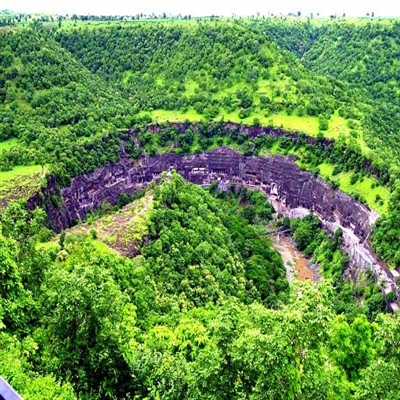
Ajanta Caves Aerial View

Ajanta Caves
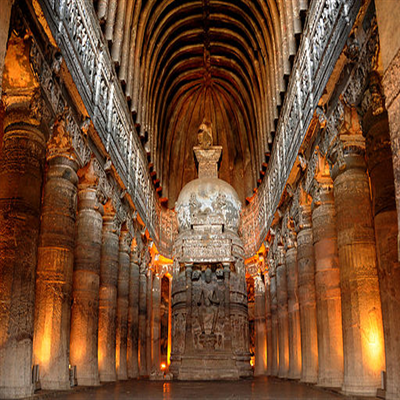
Ajanta Caves Interiors
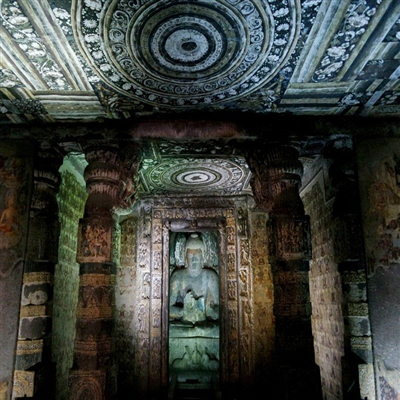
Ajanta Caves Interiors
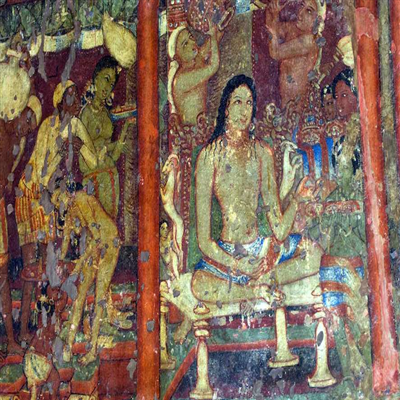
Ajanta Caves Murals
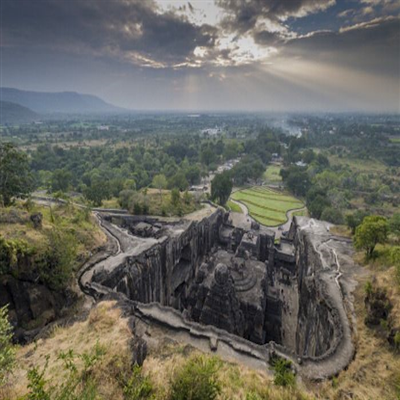
Ellora Caves Aerial view
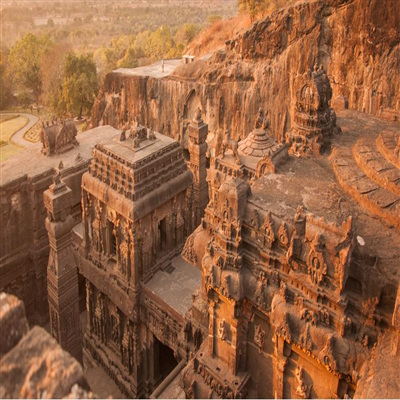
Ellora caves

Ellora caves
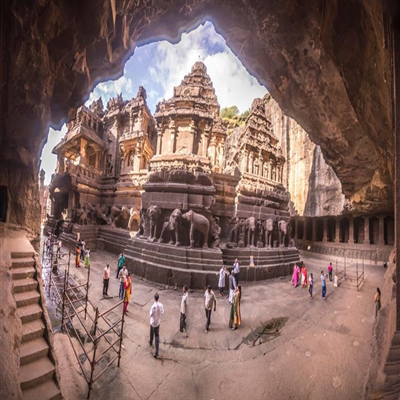
Ellora caves
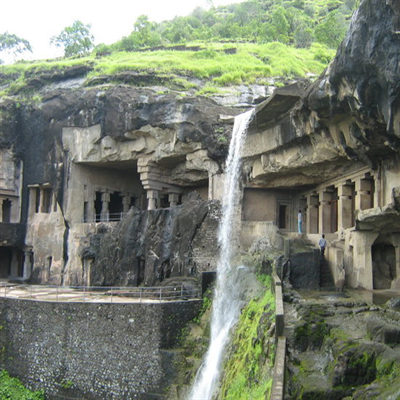
Ellora caves
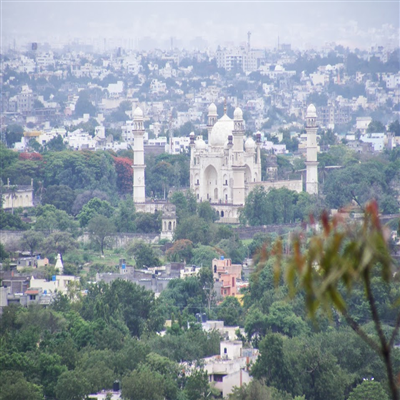
Aurangabad city

Aurangabad City
Day : 5 - A day in Aurangabad
Halt K1 - Pitalkhora Caves, Chandikawadi, Maharashtra, India
Distance from days start -60 Kms.
Activities - Visit Pithalkhora Buddhist Caves, Visit Patnadevi Waterfalls and temple
Factors at the Halt include : Spiritual,Caves / Springs.
Night stay at L2 - Aurangabad, Maharashtra, India
Distance from days start -0 Kms.
Star Rating of Hotel :




Halt L2 - Aurangabad, Maharashtra, India
Distance from days start -0 Kms.
Activities - Visit Aurangabad Caves, Visit Bibi Ka Maqbara, Visit Makai Gate
Factors at the Halt include : Spiritual,Caves / Springs.
Aurangabad being a city rich in history, this day we shall spend covering its most important sites. We shall begin with going on a 2 hour drive to visit the Pitalkhora Buddhist Caves. The Pitalkhora Caves, is situated in the Satamala range of the Western Ghats of Maharashtra. It is an ancient Buddhist site consisting of 14 rock-cut cave monuments which date back to the third century BCE, making them one of the earliest examples of rock-cut architecture in India. Located about 40 kilometers west of Ellora, the site is reached by a steep climb down a flight of concrete stairs, past a waterfall next to the caves. The caves are cut in a variety of basalt rock, but some of the caves have crumbled and are damaged. Out of the 14, four are chaityas (one housing votive stupas, one apsidal and single-cell) and the rest are viharas. All the caves belong to the Hinayana period, but the reasonably well preserved paintings are of the Mahayana period. The caves are in two groups, one of 10 caves and the second of four. The inscriptions date from c. 250 BCE to the 3rd and 4th centuries CE. There are a series of waterfalls nearby the area and Patnadevi temples and waterfalls is one among them. Devotees around nearby places visit the temple to pay obeisance. Most of the architecture in the temple is in dilapidated condition, but still one can sense the old age of the temple. River Dongari originates and flows besides the temple. This temple is said to be built in 11th century during Yadav dyanasty.
There are many places to see around this sanctuary. Some of them are:
Temple of Goddess Chandika built in 11th century
Temple of Mahadeo built in 12th century
Dhavaltirth waterfall
Kedarkund waterfall
Pitalkhora caves
Sita caves, Nagarjun caves, Shrungar chavadi cave
Fort Kanhergad
On returning to Aurgangabad after that we can explore the sights within the city and around. The Aurangabad caves, a twelve rock-cut Buddhist shrines located on a hill running roughly east to west, close to the city of Aurangabad. The Aurangabad Caves were dug out of comparatively soft basalt rock during the 6th and 7th century. The caves are divided into three separate groups depending on their location: these are usually called the "Western Group", with Caves I to V (1 to 5), the "Eastern Group", with Caves VI to IX (6 to 9), and a "Northern Cluster", with the unfinished Caves X to XII (9 to 12). The carvings at the Aurangabad Caves are notable for including Hinayana style stupa, Mahayana art work and Vajrayana goddess. These caves are among those in India that show 1st millennium CE Buddhist artwork with goddesses such as Durga, and gods such as Ganesha. Numerous Buddhist deities of the Tantra tradition are also carved in these caves.
Then there is 'The Bibi Ka Maqbara' (English: "Tomb of the Lady") is a tomb located in Aurangaba. It was commissioned in 1660 by the Mughal emperor Aurangzeb in the memory of his first and chief wife Dilras Banu Begum (posthumously known as Rabia-ud-Daurani) and is considered to be a symbol of Aurangzeb's 'conjugal fidelity'. It bears a striking resemblance to the Taj Mahal, the mausoleum of Aurangzeb's mother, Mumtaz Mahal.
The comparison to the Taj Mahal has often obscured its very own considerable charm. Due to the strong resemblance, it is also called the Dakkhani Taj (Taj of the Deccan). Bibi Ka Maqbara is the "principal monument" of Aurangabad and its historic city. An inscription found on the main entrance door mentions that this mausoleum was designed and erected by Ata-ullah, an architect and Hanspat Rai, an engineer respectively. Ata-ullah was the son of Ustad Ahmad Lahauri, the principal designer of the Taj Mahal. Aurangzeb's son, Muhammad Azam Shah was in later years put in charge of overseeing the repair-work of Taj Mahal. Bibi Ka Maqbara is believed to have been built between 1668 and 1669 C.E. According to the "Tarikh Namah" of Ghulam Mustafa, the cost of construction of the mausoleum was Rs. 668,203-7, Aurangzeb allocated Rs. 700,000 for its construction. The Gates of Aurangabad distinguish it from several other medieval cities in India. There are 52 gates in the city of Aurangabad due to which it is also known as the City of Gates. We shall drive through some among the more splendid ones including the Makai gate or the Gate to Mecca, Bhadkal gate and the Delhi gate.
Media and additional information available for the day's itinerary.
![]()
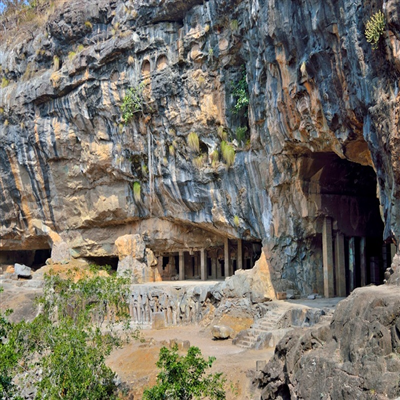
Pitalkhora Caves
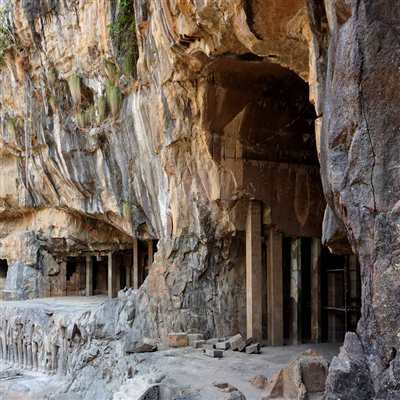
Pitalkhora Caves
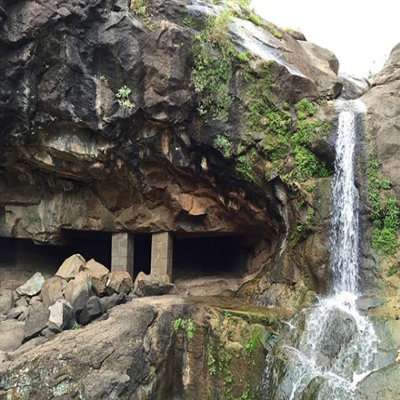
Pitalkhora Caves
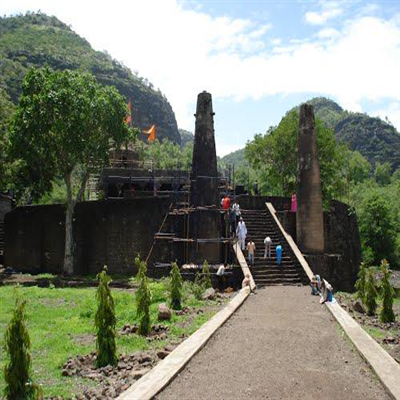
Patnadevi Temple

Patnadevi Temple
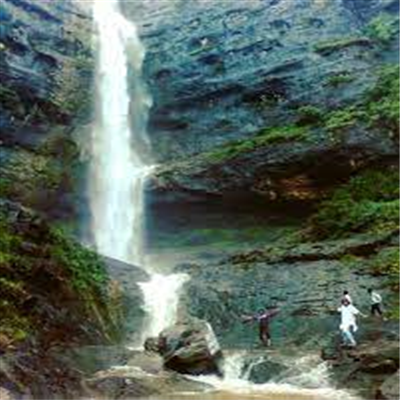
Kedarkund waterfalls
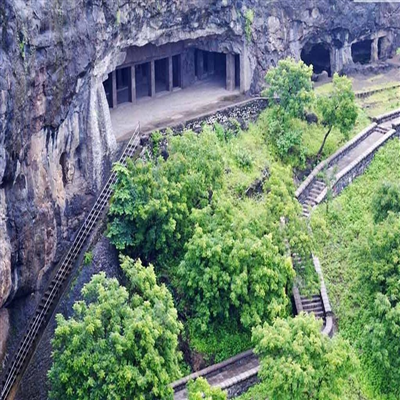
Aurangabad Caves

Aurangabad Caves
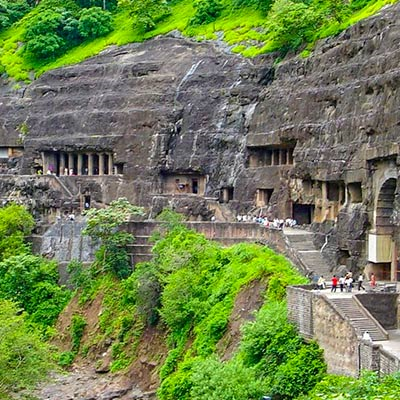
Aurangabad Caves

Bibi Ka Makabra
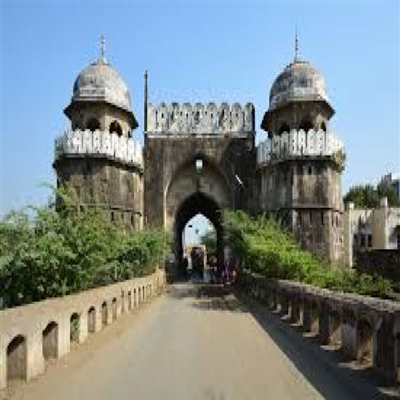
Makai Gate
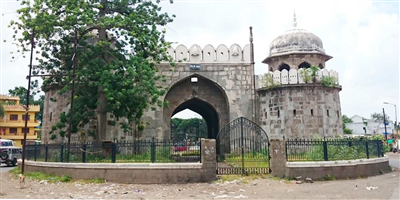
Delhi Gate
Day : 6 - The Shirdi Temple
Halt M1 - Shirdi, Maharashtra, India
Distance from days start -91 Kms.
Activities - Visit Shirdi Sai Baba Sansthan Temple
Factors at the Halt include : Spiritual.
Night stay at N2 - Sangamner, Maharashtra, India
Distance from days start -123 Kms.
Star Rating of Hotel :




Shirdi temple is a temple devoted to Sai Baba of Shirdi (died 15 October 1918), also known as Shirdi Sai Baba. Shirdi Sai Baba was an Indian spiritual master who is regarded by his devotees to be a manifestation of Sri Dattaguru and identified as a saint and a fakir. He was revered by both his Hindu and Muslim devotees during, as well as after his lifetime. According to accounts from his life, he preached the importance of "realization of the self" and criticized "love towards perishable things". His teachings concentrate on a moral code of love, forgiveness, helping others, charity, contentment, inner peace and devotion to the God and guru. He stressed the importance of surrender to the true Satguru, who, having trod the path to divine consciousness, will lead the disciple through the jungle of spiritual training. Sai Baba also condemned distinction based on religion or caste. It remains unclear if he was a Muslim or a Hindu. This, however, was of no consequence to Sai Baba. His teachings combined elements of Hinduism and Islam: he gave the Hindu name Dwarakamayi to the mosque in which he lived, practised both Hindu and Muslim rituals, taught using words and figures that drew from both traditions and took samadhi in Shirdi. One of his well-known epigrams, Allah Malik (God is King) and Sabka Malik Ek (Everyone's Master is One), is associated with both Hinduism and Islam. The Shirdi temple is 2 and half hour drive from Aurangabad. After visiting the temple we can move onto the town of Sangamner and spend the night there.
Media and additional information available for the day's itinerary.
![]()

Shirdi Sai Baba temple
.jpg)
Rituals at Shirdi Sai Baba temple
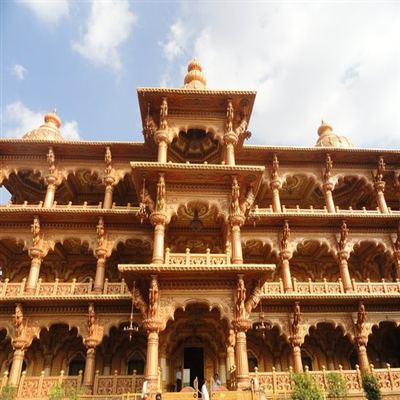
Shirdi Sai Baba temple
Day : 7 - Malshej Ghat and Naneghat
Halt O1 - Reverse Waterfall Naneghat, Naneghat Road, Taluka, Junnar, Maharashtra, India
Distance from days start -64 Kms.
Activities - Visit Reverse Waterfalls Naneghat
Factors at the Halt include : Great Views.
Halt P2 - Malshej Ghat, Maharashtra
Distance from days start -52 Kms.
Activities - Drive through Malshej Ghats
Factors at the Halt include : Treks,Great Views.
Night stay at Q3 - Mumbai, Maharashtra, India
Distance from days start -150 Kms.
Star Rating of Hotel :



Halt Q3 - Mumbai, Maharashtra, India
Distance from days start -150 Kms.
Activities - Mumbai city tour
Factors at the Halt include :
On Day 7 we shall leave from Sangamner to Naneghat set in the western ghats of Maharashtra. It is a 2.5 hour pleasant drive to reach the Naneghat which is other wise famous for its mountain trekking routes and the famous Reverse waterfalls. The waterfalls is called reverse waterfalls because of the water cascading down the hill sides are swept and flown back to the top of the hills due to the wind pressure in the cliffs. From Naneghat we shall proceed to the Malshej ghats which is famous for its glorious mountain views especially during the monsoons where there are waterfalls springing from all across the mountain sides. From Malshej Ghats we shall proceed onto Mumbai which is a 3.5 hour drive. On reaching Mumbai before checking into our hotel we can have a little city tour of this bustling metropolis, the 4 th largest city in the world.
Media and additional information available for the day's itinerary.
![]()
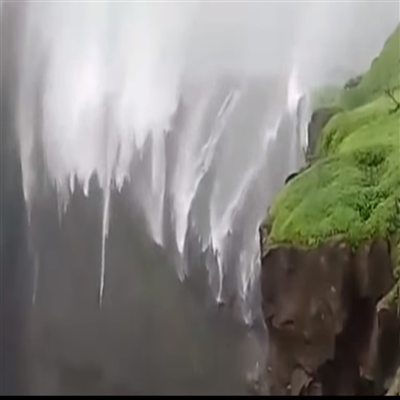
Naneghat Reverse waterfalls
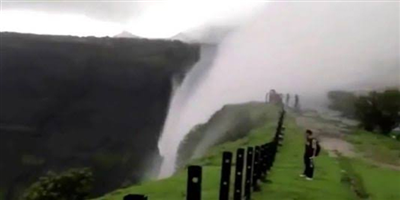
Naneghat Reverse waterfalls
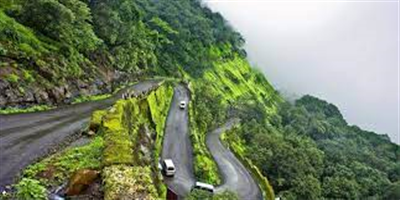
Malshej Ghat road

Malshej ghat during Monsoons

Malshej Ghat
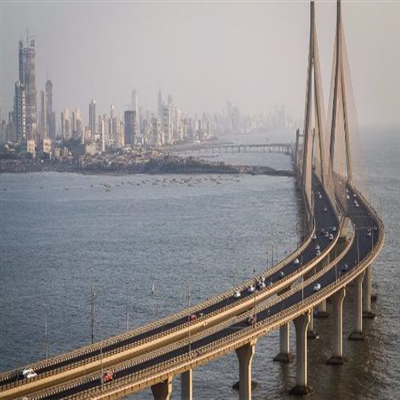
Mumbai City Views

Mumbai City Views
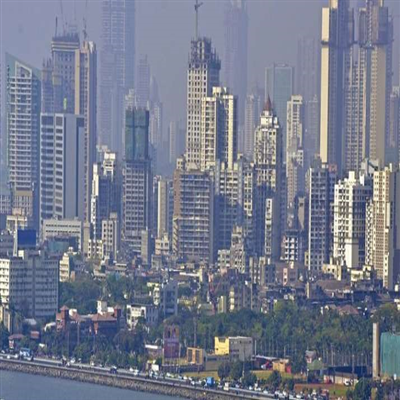
Mumbai City Views
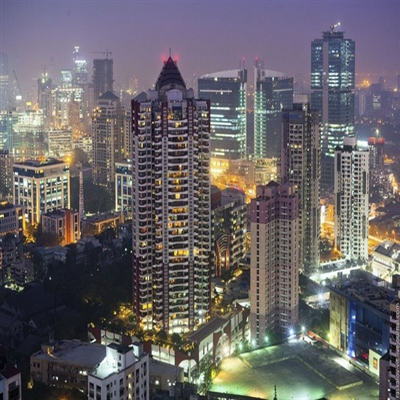
Mumbai City Views
Day : 8 - And the Elephenta Caves
Halt R1 - Elephanta Caves, Gharapuri, Maharashtra, India
Distance from days start -17 Kms.
Activities - Visit Elephenta Caves
Factors at the Halt include : Spiritual,Small Boats / Canoes,Caves / Springs.
Just about 40 minute drive and a short ferry ride from Mumbai city we can reach the island of Gharapuri or the island of caves or the Elephenta islands. Designated by UNESCO as a World Heritage Site, the Elephanta Caves are a collection of cave temples predominantly dedicated to the Hindu god Shiva. They are on Elephanta Island, or Gharapuri (literally "the city of caves"), in Mumbai Harbour, 10 kilometres (6.2 mi) east of Mumbai in the Indian state of Maharashtra. The island, about 2 kilometres (1.2 mi) west of the Jawaharlal Nehru Port, consists of five Hindu caves, a few Buddhist stupa mounds that date back to the 2nd century BCE, and two Buddhist caves with water tanks. The Elephanta Caves contain rock cut stone sculptures, mostly in high relief, that show syncretism of Hindu and Buddhist ideas and iconography. The caves are hewn from solid basalt rock. Except for a few exceptions, much of the artwork is defaced and damaged. The main temple's orientation as well as the relative location of other temples are placed in a mandala pattern. The carvings narrate Hindu mythologies, with the large monolithic 20 feet (6.1 m) Trimurti Sadashiva (three-faced Shiva), Nataraja (Lord of dance) and Yogishvara (Lord of Yoga) being the most celebrated. These date to between the 5th and 9th centuries, and scholars attribute them to various Hindu dynasties. They are most commonly placed between the 5th and 7th centuries. Many scholars consider them to have been completed by about 550 CE.
They were named Elefante – which morphed to Elephanta – by the colonial Portuguese who found elephant statues on the caves. They established a base on the island. The main cave (Cave 1, or the Great Cave) was a Hindu place of worship until the Portuguese arrived, whereupon the island ceased to be an active place of worship. The earliest attempts to prevent further damage to the caves were started by British India officials in 1909. The monuments were restored in the 1970s. In 1987, the restored Elephanta Caves were designated a UNESCO World Heritage Site. It is currently maintained by the Archaeological Survey of India (ASI). After visiting the Elephenta caves we shall be ready to head to airport according to your return flight timings.
Media and additional information available for the day's itinerary.
![]()
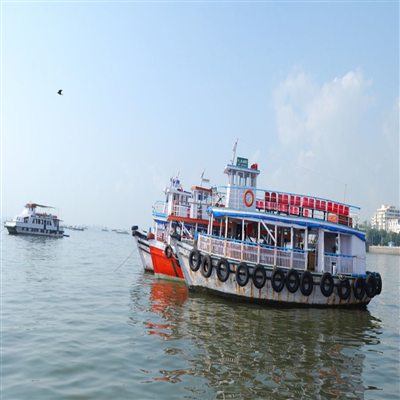
Ferry ride to Elephenta islands
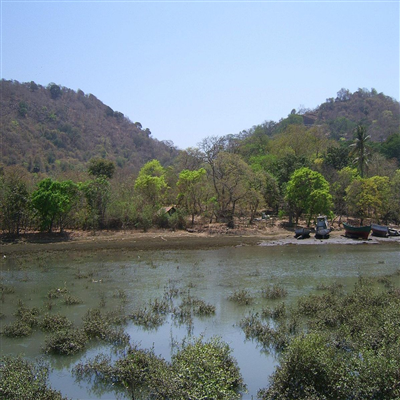
Elephenta Island
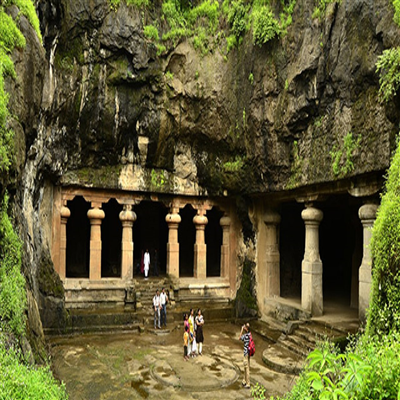
Elephenta cave entrance

Elephenta Caves
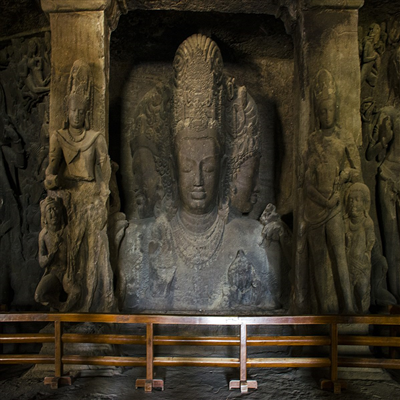
Sculptures in Elephenta Caves

Another part of the Elephenta Caves